
[Source: Alan Young] Bassenthwaite Lake Station Gallery 2: Early 1950s - cMid 1950s 
In the early 1950s, Ivatt 2MT 2-6-0 No.46459 draws a passenger train into Bassenthwaite Lake station. The up platform, seen here, is still fitted with what is probably an LMS nameboard, but repainted in BR(LM) maroon. Part of the enclosed waiting shelter is visible, and there is a glimpse of the fine station garden. The train’s first two coaches are ex-LNWR: a Lavatory Third behind the locomotive followed by what appears to be a Brake Third. Then comes a Lavatory Composite, apparently LMS, in early British Railways carmine and cream (otherwise known as blood and custard) livery. The final carriage is another Brake with passenger accommodation.
Photo from John Mann collection 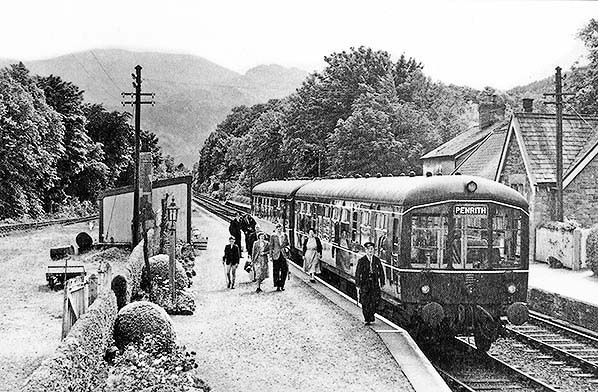
Diesel Multiple Units were introduced on the former CK&P in early January 1955. This view, thought to be in summer 1955, is looking south-east from the signal box at Bassenthwaite Lake station. Several passengers have alighted from the ‘Derby Lightweight’ unit onto the up platform. The well-tended station garden is a delightful feature on many photographs of this station.
Photo from John Mann collection 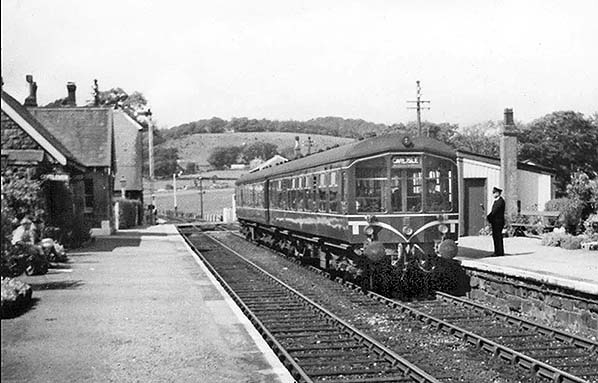
On a summer day in 1957 a 'Derby Lightweight' 2-car DMU awaits departure for Carlisle on the up platform. This is another view showing the well-tended station flower beds on both platforms.
Photo from James Lake collection 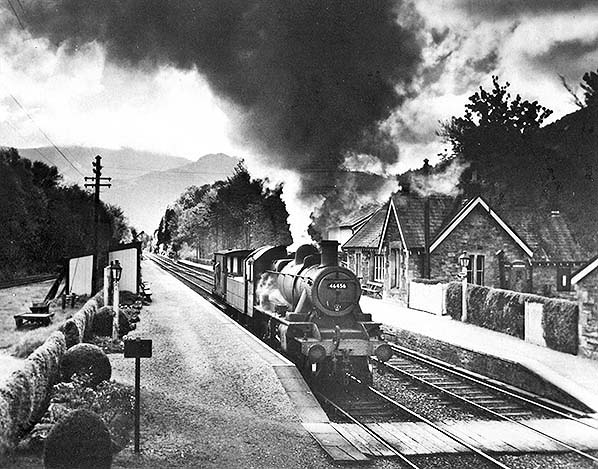 In the late 1950s, Ivatt Class 2MT 2-6-0 No.46456 is creating a spectacular cloud as it pulls away from Bassenthwaite Lake station. It is likely that the locomotive is propelling the 20-ton brake van – a not uncommon practice - given that it is apparently running ‘wrong line’; the lower quadrant starting signal can be seen pulled off in the distance; the lamp on the engine’s buffer beam is probably a tail lamp rather than a head lamp; and the direction of the plume of smoke suggests that the loco is receding. The view is south-eastwards from the signal box. The station building on the down platform is to the right of the engine and the up platform’s timber shelter can also be seen. A BR(LM) totem nameplate has recently been fixed to the lamp post on the down platform.
Photo by Ivor Nicholas  The ‘Lakes Express’ has arrived at Bassenthwaite Lake station circa late 1950s hauled by an Ivatt 2MT No 46458. The ‘Lakes Express’ was started by the LMS as a summer-only service from Euston to a host of destinations in the north-west that were served by portions detached along the way, and delivered to their destinations by smaller locos; these portions operated to Keswick/Workington, Windermere, Whitehaven, Morecambe and Blackpool.
Photo from James Lake collection 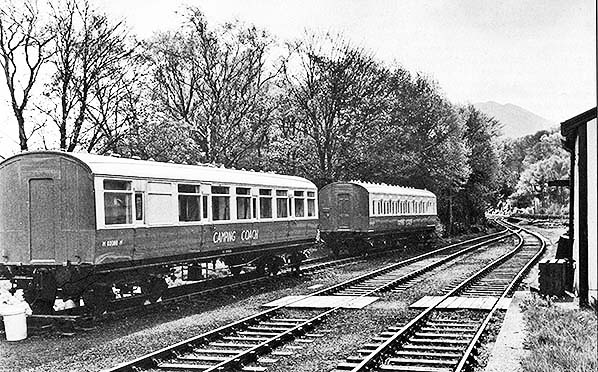
Bassenthwaite Lake was one of many stations in scenic locations to host camping coaches in the summer. They were stabled in a disconnected siding in the goods yard and each winter the adjacent siding was slewed so that the coaches could be removed for maintenance and storage. The coaches are in green and cream livery.
Photo by Ivor Nicholas

Circa 1960 an up diesel multiple unit is passing over the level crossing and about to enter Bassenthwaite Lake station. The signalman is prepared to take the single line token from the driver, while someone is photographing the scene from the signal box. The box is a CK&P structure dating from 1911 which replaced one of Saxby design. The DMU is a ‘Derby Lightweight’ of the original ‘Yellow Diamond’ 79xxx series. These were ‘West Cumberland’ sets introduced in stages: Workington, Keswick and Penrith was Stage 2, commencing public service on 3 January 1955. The bars over the door droplights are installed because of limited clearances in the Workington / Whitehaven area. The first coach is a Driving Motor Brake Third, still carrying the BR ‘cycling lion’ emblem. The Driving Trailer also appears to carry this emblem. The ‘whiskers’ design on the front started as an experiment in 1957-58 to enliven the somewhat lumpen appearance of the vehicles and thereafter it was applied rapidly across most of the DMU fleet. The design was probably officially introduced in 1958.
Photo from Derwent Railway Society 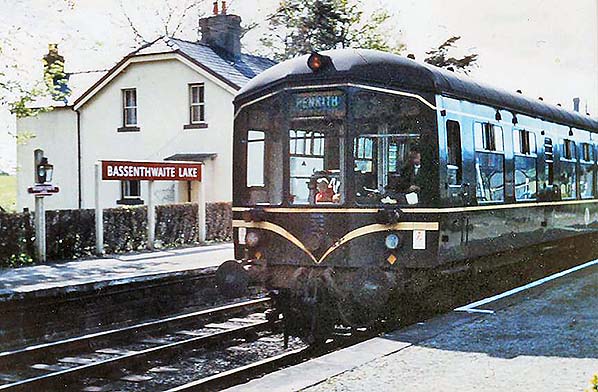
A ‘Derby Lightweight’ DMU travelling towards Keswick and Penrith has arrived at Bassenthwaite Lake station. The date is circa 1960. The DMU is sporting the ‘whiskers’ design which was introduced in 1957-58. Behind the train the staff cottages can be seen. The station has recently been re-signed with a British Railways (London Midland Region) vitreous enamel nameboard and a totem nameplate affixed to the lamp standard.
Photo from Derwent Railway Society  On a winter’s day c1960 the view is southwards at Bassenthwaite Lake station, looking towards Sale Fell. The A594 road is crossing the railway. A plume of smoke is carried from the chimney of the signal box, a structure of their own design installed by the Cockermouth, Keswick & Penrith Railway in 1911.
Photo from Derwent Railway Society 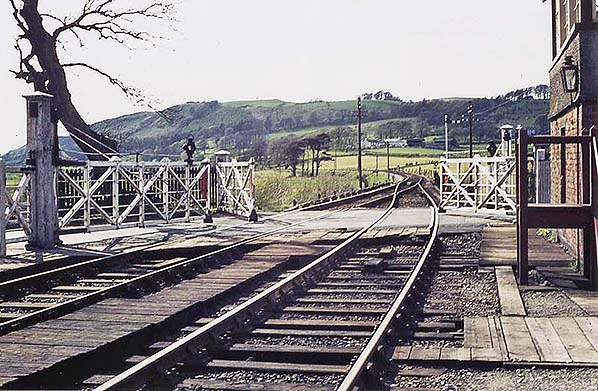
Looking north-west over the level crossing at Bassenthwaite Lake station c1960. The signal box is to the right with a gas lantern fixed to it. Gas lighting at rural stations was rare, but all of the minor CK&P stations had it installed in the late 19th and early 20th centuries.
Photo from Derwent Railway Society
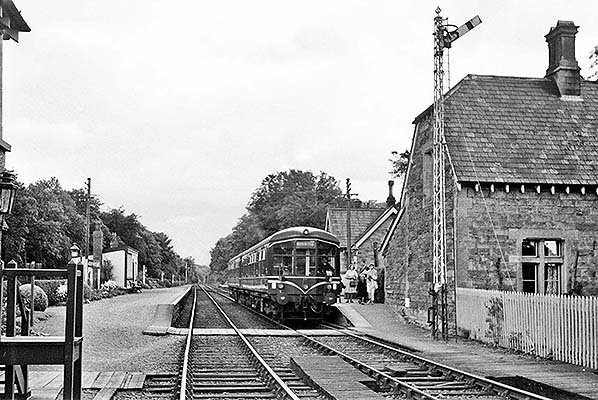 A 'Derby Leighweight' DMU bound for Workington waits in the up platform in July 1962. The photo is taken from the level crossing.
Photo from James Lake collection 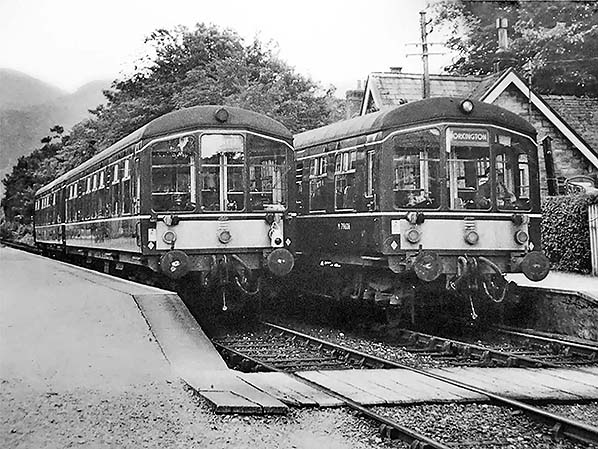 A pair of ‘Derby Lightweight’ DMUs pass at Bassenthwaite station circa mid 1960s. By this date the livery had changed with the whiskers being replaced by a yellow band below the driver's window. The two sets seen here are from the original West Cumberland batch, identifiable by the side-mounted windscreen wipers and strengthening bar behind the windscreens. When new they suffered structural problems and the strengthening bar had to be added at a later date. These West Cumberland sets had bars over the door droplights, as can be seen here, and were 3in narrower than the units allocated elsewhere. The reduced body width was achieved by means of smaller bodyside fittings such as handles and stepboards. A pair of ‘Derby Lightweight’ DMUs pass at Bassenthwaite station circa mid 1960s. By this date the livery had changed with the whiskers being replaced by a yellow band below the driver's window. The two sets seen here are from the original West Cumberland batch, identifiable by the side-mounted windscreen wipers and strengthening bar behind the windscreens. When new they suffered structural problems and the strengthening bar had to be added at a later date. These West Cumberland sets had bars over the door droplights, as can be seen here, and were 3in narrower than the units allocated elsewhere. The reduced body width was achieved by means of smaller bodyside fittings such as handles and stepboards.Photo from James Lake collection Click here for Bassenthwaite Lake Station Gallery 3:
|


 Home Page
Home Page